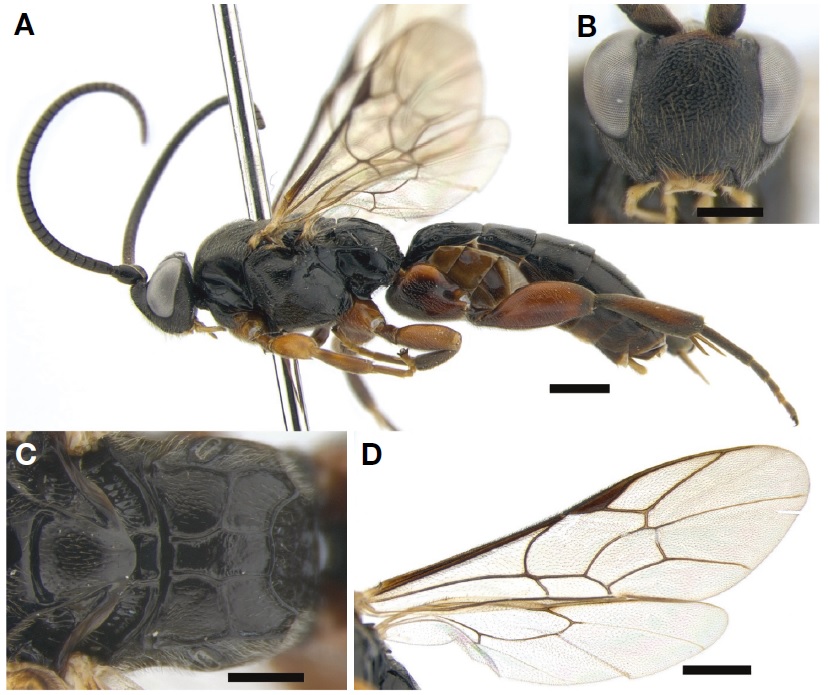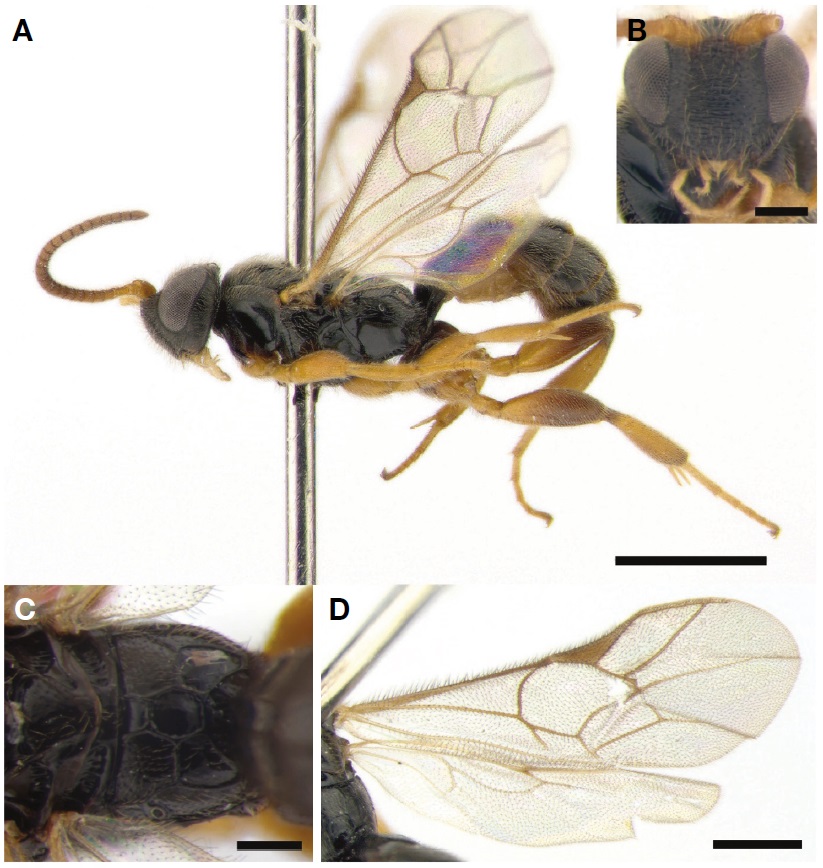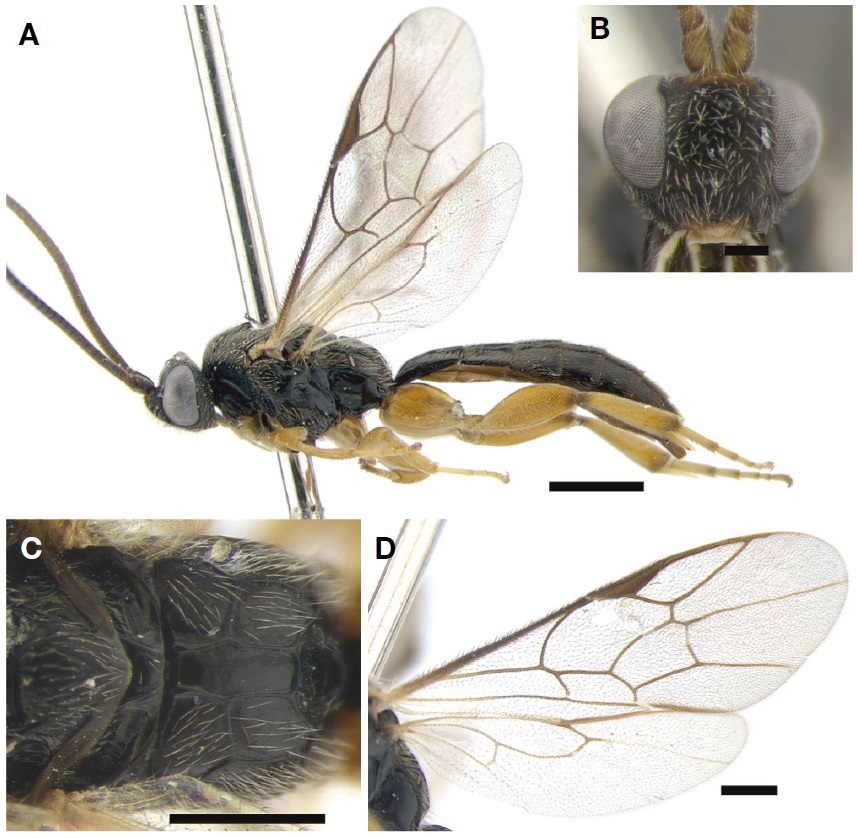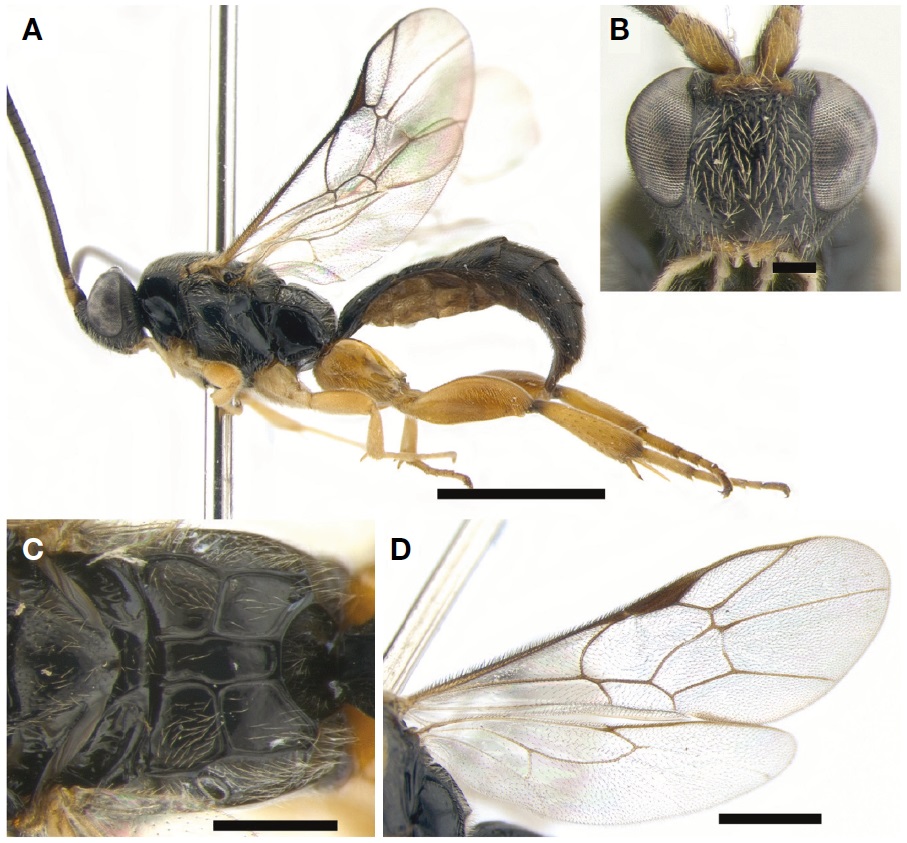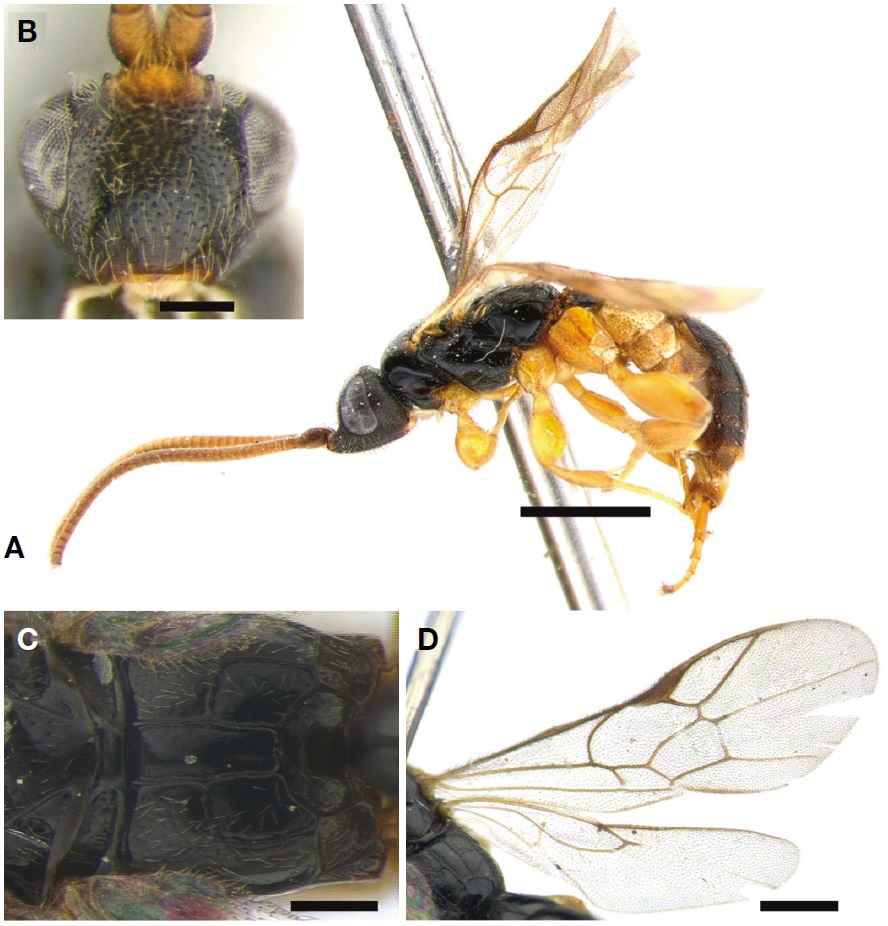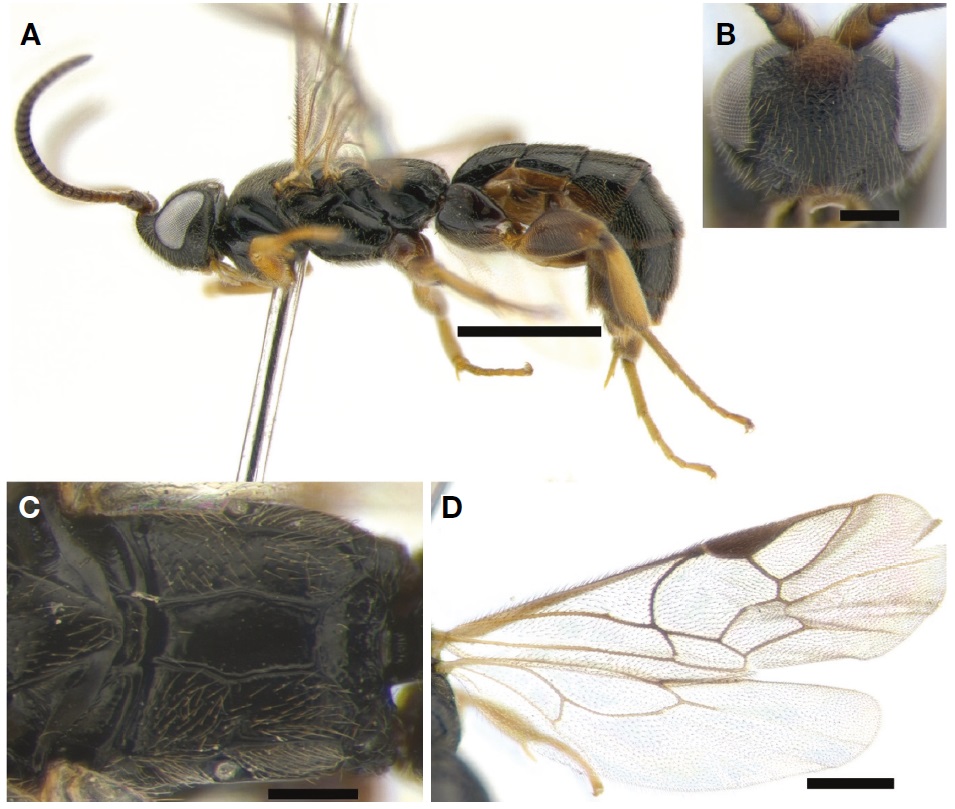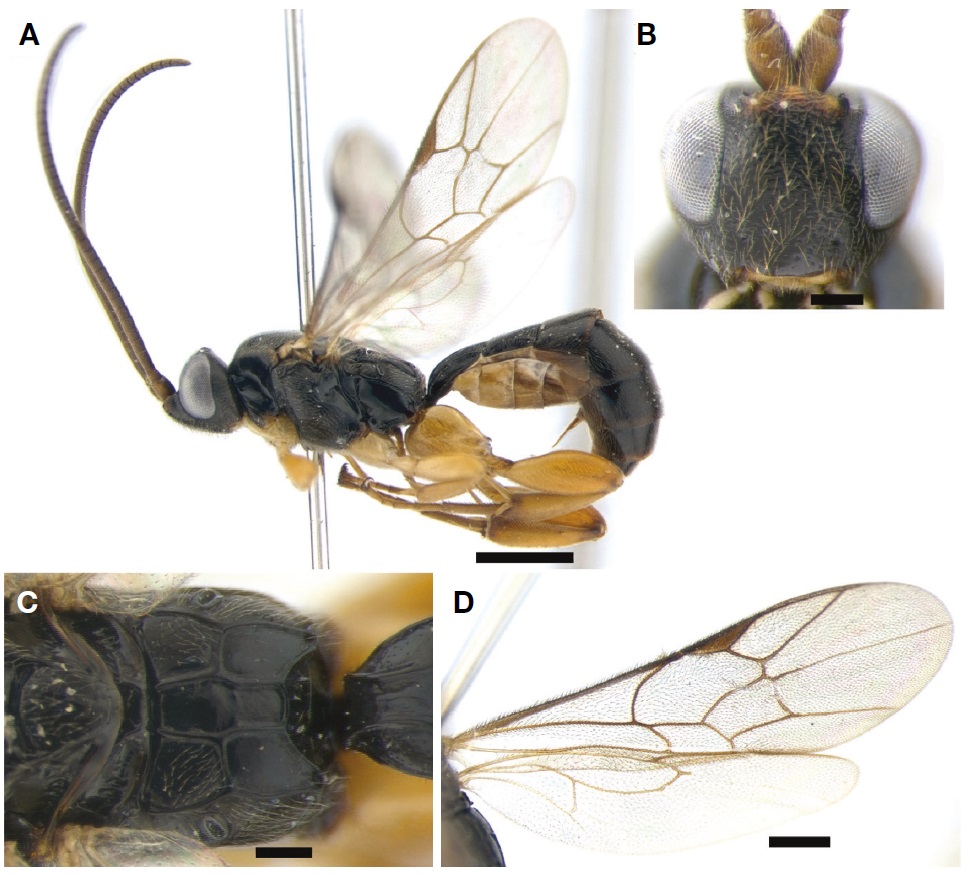



The subfamily Metopiinae is a cosmopolitan group comprising 836 species within 26 genera. Among them, 275 species have been recorded from the Eastern Palaearctic region (Yu et al., 2012).
The images of the specimens were taken using an Axio Cam MRc5 camera attached to a stereo microscope (Zeiss SteREO Discovery, V20; Carl Zeiss, Göttingen, Germany), processed using AxioVision SE64 software (Carl Zeiss), and optimized with a Delta imaging system (i-solution, IMT i-Solution Inc. Vancouver, Canada). The morphological terminology mostly follows that of Townes (1969). Abbreviations were as follows: ANSP, Academy of Natural Sciences of Philadelphia, Philadelphia, PA, 19103, USA; BBM, Bernice P. Bishop Museum, Department of Entomology, Honolulu, HI, 96817, USA; HU, Entomological Institute, Faculty of Agriculture, Hokkaido University, Sapporo, Japan; MACN, Museo Argentino de Ciencias Naturales, Avenida Angel Gallardo 470, 1405 Buenos Aires, Argentina; MHN, Muséum d’Histoire Naturelle, Route de Malagnou, CH-1211 Genève, Switzerland; MNHN, Muséum National d’Histoire Naturelle, Entomologie, 45 Rue de Buffon, Paris, 75005, France; NHM, The Natural History Museum, Department of Entomology, Cromwell Road, London, England, SW7 5BD, United Kingdom; MOMOI, Kobe University, Faculty of Agriculture, Entomological Laboratory, Kobe, Japan (S. Momoi collection); YNU, Yeungnam University, Gyeongsan, Korea; ZIN, Zoological Institute, Academy of Sciences, St. Petersburg 199034, Russia; GW, Gangwon-do; GG, Gyeonggi-do; CB, Chungcheongbuk-do; CN, Chungcheongnam-do; GB, Gyeongsangbuk-do; GN, Gyeongsangnam-do; JB, Jeollabuk-do; JN, Jeollanam-do; JJ, Jeju-do; TD, Type depository; TS, Type species.
>
Diagnosis. Combined face and clypeus strongly convex transversely, weakly convex longitudinally. Upper edge of face produced between antennal sockets as a short broad point that is bent slightly backward between the bases of the antennae. Back of head dropping, vertically from hind ocelli to foramen magnum. Lower tooth of mandible much shorter than upper tooth. Antenna rather short to long, filiform. Scutellum weakly convex, without a lateral carina. Areolet absent. Sternaulus broad, moderately long. Legs stout. Spurs of mid tibia approximately equal length. 1st tergite rather narrow basally, its spiracle near basal 0.35, its lateral longitudinal carina sharp, usually to the apex, its median dorsal carina sharp basally, usually obsolescent somewhere behind the middle of the tergite. Ovipositor sheath short, not surpassing the tip of the abdomen.
>
Key to species of the genus Hypsicera from South Korea (modified from
>
Material examined. South Korea: 1♂, CN: Dangjin-gun, Sinpyeong-myeon, Geumcheon-ri, 10 Sep 2006, Lee HS (YNU); 1♀, Seosan-si, Haemi-myeon, Daegok-ri, Hanseo Univ., 11-23 Jun 2009, Lee JW (YNU); 1♂, ditto, 9-21 Oct 2006, Kim JG (YNU); 1♀, GB: Cheongdo-gun, Unmun-myeon, Mt. Unmunsan, 6-19 Jun 2008, Lee JW (YNU); 1♂, ditto, 24-30 May 2009, Kwon HJ (YNU); 1♀3♂♂, GB: Cheongdo-gun, Unmun-myeon, Unmunsa, 28 May 1989, Kim JG (YNU); 1♀, Gyeongsan-si, Dae-dong, Yeongnam Univ., 29 May 1989, Hwa GJ (YNU); 1♀, ditto, 30 May 1989, Kim JG; 1♂, ditto, 9 Jun 1989, Kim JG (YNU); 1♀, ditto, 16 Jun 1989, Kim JG (YNU); 1♂, ditto, 5 Sep 1989, Kim JG (YNU); 1♀, GG: Anyang-si, Manan-gu, Kwanag, 9-24 Jun 2007, Lim JO (YNU); 1♀, GN: Jinju-si, Gajwa-dong, 26 May-2 Jun 1987, Park JS (YNU); 1♀, Sancheong-gun, Sicheon-myeon, Jungsan-ri, Jirisan National Park, Sunduryu, 10 Jun 1989, Kim JG (YNU); 1♀, Ulju-gun, Sangbuk-myeon, Icheon-ri, 13 Jun 1989, Kim JG (YNU); 1♀, GW: Donghae-si, Samhwa-dong, Mureung valley, 21-30 May 2005, Lee JW (YNU); 1♀, JJ: Jeju-si, Ara 1-dong, Jeju Univ., Alt. 333 m, 1-10 Jun 2009, Lee JW (YNU).
Diagnosis. Female: Forewing 6.9 mm (6.0-7.3 mm), body 11.3 mm (10.5-12.0 mm).
Antenna blackish brown, dorsal part of scape black. Apical of flagellum rather bright. Thorax black. Hind coxa, trochanter, trochantellus, femur and basitarsus brownish yellow, except for black basal part of basitarsus. Remainder segments of tarsus brown. Abdomen black.
Ocellus moderately large, its diameter 1.2 times as long as distance between lateral ocellus and eye. Antenna with 43 flagellomeres. First flagellomere 2.0 times as long as wide. Malar space 3.2 times as long as basal mandibular width. Epomia strong. Hind wing with seven distal hamuli. Legs moderately stout, hind femur 2.6 times as long as wide. Ratio between lengths of hind tarsal segments 9 : 4 : 3 : 2 : 3. Fore and mid tarsal claws pectinate. Hind tarsal claw simple. Basal area of propodeum not separated from areola by carina. Median dorsal carina strongly extending on basal 0.7 of the first tergite.
Male: Flagellum with 45 flagellomeres. Other characters as in female.
Distribution. South Korea (new record), Japan (Okinawa).
Region. Eastern Palaearctic, Oriental.
>
Material examined. South Korea: 1♀, Seoul: Nowon-gu, Sanggye-dong, Mt. Suraksan, 18 Jul-24 Aug 2007, Lim JO (YNU).
Description. Female: Forewing 3.0 mm, body 4.2 mm.
Black. Head black. Palpi yellow. Mandible blackish brown with brown mandibular tooth. Antenna yellow with brown apical. Scape yellow. Pedicel bright yellow. Thorax black. Tegula yellow. Fore and mid leg yellow. Hind coxa blackish brown with yellow apical half. Trochanter and trochantellus yellow. Femur brown with yellow basal half. Tibia yellow with brown basal and apical. Tarsus yellow. Tarsal claw brown. Wings hyaline. Abdomen black.
In dorsal view, head slightly narrowed behind eyes, rather convex. Temple shorter than transversal diameter of eye. Ocellus moderately small, its diameter 0.7 times as long as the distance between the lateral ocellus and the eye. Frons coriaceous, finely striate-punctate, its antennal scrobe strongly concave, polished without punctures. Antenna with 24 flagellomeres, filiform. Scape densely punctate. First flagellomere 2.0 times as long as wide. Face almost rectangle, coarsely and densely punctate, puncture almost tending to transversely confluent. Clypeus not separated from face, with distant punctures. Mandible tapered apically. Malar space 1.2 times as long as basal mandibular width. Occipital carina present dorsolaterally.
Epomia present, notaulus weakly present. Postscutellum polished with dense puncture. Scutellum polished with fine puncture. Propleuron densely punctate, pronotum polished without puncture, extremely concave. Mesopleuron shiny, with a few sparse punctures. Prepectal carina complete, reaching the subtegular ridge. Metapleuron polished without puncture, pleural carina strong. Submetapleural carina complete. Hind wing with seven distal hamuli. Legs stout, hind femur 2.3 times as long as wide. Ratio between lengths of hind tarsal segments as 20 : 10 : 6 : 5 : 6. All tarsal claws simple. Basal area of propodeum separated from areola by carina. Propodeum polished with a few hair. Propodeal spiracle 1.5 times as long as wide.
Abdomen polished, with fine punctures. Median dorsal carina strongly extending to near apex of 1st tergite. Ovipositor sheath short, not surpassing tip of metasoma.
Male: No examined.
Distribution. South Korea (new record), Japan (Okinawa), Russia (Khabarovsk Kray).
Region. Eastern Palaearctic, Oriental.
Remark. Female characteristics of this species are described here for the first time.
>
Material examined. South Korea: 1♂, CB: Boeun-gun, Sanae-ri, Songnisan National Park, Beomjusa, 5 May-31 Aug 2011, Jeong JC (YNU); 1♂, Daejeon: Dong-gu, Daejeon Univ., 12-27 May 2007, Lee JW (YNU); 2♂♂, GB: Cheongdo-gun, Unmun-myeon, Mt. Unmunsan, Simsimgyegok, 29 Aug-19 Sep 2014, Lee JW (YNU); 1♂, ditto, 30 Jul-29 Aug 2014, Lee JW; 1♂, GB: Gyeongsan-si, Dae-dong, Yeongnam Univ., 9 Jun 1989, Kim JG (YNU); 1♂, GN: Hadong-gun, Hwagae-myeon, Jirisan National Park, Daeseonggol, 29 Jul 1989, Kim JG (YNU); 1♂, GW: Donghae-si, Samhwa-dong, Mureung valley, 21-30 May 2005, Lee JW (YNU); 1♂, JN: Suncheon-si, Seungju-eup, Jukak-ri, Seonamsa, 10 Jul 1998 (YNU).
Additional material. China: 1♂, Sanhezhen, Yanbian, Jirin, Alt. 923 m, 22 Jul 2010, Lee JW (YNU).
Diagnosis. Male: Forewing 3.2 mm (3.0-3.6 mm), body 5.4 mm (5.4-5.7 mm).
Antenna yellowish brown. Scape more bright, dorsal part of scape black. Thorax brownish black. Hind leg yellow except for black basal of tibia. Abdomen reddish brown.
Ocellus moderately small, its diameter 1.3 times as long as distance between lateral ocellus and eye. Antenna with 32 flagellomeres. First flagellomere 2.2 times as long as wide. Malar space 2.3 times as long as basal mandibular width. Epomia present. Prepectal carina reaching half of the pronotum. Hind wing with five distal hamuli. Legs moderately stout, hind femur 3.2 times as long as wide. Ratio between lengths of hind tarsal segments 11 : 6 : 5 : 3 : 5. All tarsal claws simple. Basal area of propodeum not separated from areola by carina. Combined basal area and areola shiny with a few punctures. Second lateral area with some long setae. Propodeal spiracle 2.0 times as long as wide. Median dorsal carina weakly extending on basal 0.3 of the first tergite.
Female: No examined.
Distribution. South Korea (new record), China (Jirin-new record), Japan (Okinawa).
Region. Eastern Palaearctic, Oriental.
>
Material examined. South Korea: 1♂, GG: Gwacheon-si, Makgye-dong, Mt. Cheonggyesan, 4 Jul 1989, Kim JG (YNU); 1♂, GN: Changnyeong-gun, Seongsan-myeon, Bang-ri, 26 Jun 1989, Kim JG (YNU); 1♀, GW: Wonju-si, Heungeop-myeon, Maeji-ri, Yeonsei Univ., 1-31 Jul 2010, Han HY (YNU); 1♂, Wonju-si, Panbu-myeon, Mt. Baegunsan, 30 Jul-28 Aug 2013, Lee JW (YNU); 2♀♀, Wonju-si, Socho-myeon, Hakgong-ri, Chiaksan National Park, 20 Jun-19 Jul 2013, Lee JW (YNU).
Diagnosis. Female: Forewing 5.3 mm (5.1-5.4 mm), body 8.5 mm (8.4-9.5 mm).
Antenna gradate blackish brown basal to brown apical. Thorax black. Hind legs brownish yellow with brown tarsal claws. Abdomen black.
Ocellus moderately small, its diameter 1.1 times as long as distance between lateral ocellus and eye. Antenna with 38 flagellomeres. First flagellomere 1.8 times as long as wide. Malar space 3.0 times as long as basal mandibular width. Occipital carina absent. Epomia strong. Hind wing with seven distal hamuli. Legs moderately stout, hind femur 3.5 times as long as wide. Ratio between lengths of hind tarsal segments 14 : 10 : 5 : 7 : 5. Fore and mid tarsal claws pectinate. Hind tarsal claw simple. Basal area not separated from areola by carina. Propodeal spiracle 2.0 times as long as wide. 1st tergite polished without puncture. Median dorsal carina extending on basal 0.6 of the first tergite.
Male: Flagellum with 40 flagellomeres. Other characters as in female.
Distribution. South Korea (new record), Japan (Okinawa).
Region. Eastern Palaearctic, Oriental.
>
Material examined. South Korea: 1♀, Daegu: Dong-gu, Mt. Palgongsan, 7 Jul 1987, Kim JG (YNU).
Additional material. Japan: 1♀, Hokkaido, Sapporo-shi, Toyohira-ku, Nishioka Park, Alt. 140 m, 27 Jul 2013, Lee JW (YNU).
Diagnosis. Female: Forewing 2.7 mm (2.7-2.9 mm), body 3.4 mm (3.4-3.5 mm).
Antenna tan brown. Dorsal part of antenna blackish brown. Thorax black. Hind leg brownish yellow with black base of tibia and brown tarsal claw. Abdomen black.
Ocellus moderately large, its diameter 0.3 times as long as distance between lateral ocellus and eye. Antenna with 34 flagellomeres. First flagellomere 1.1 times as long as wide. Malar space 3.0 times as long as basal mandibular width. Epomia present. Hind wing with six distal hamuli. Legs moderately stout, hind femur 2.2 times as long as wide. Ratio between lengths of hind tarsal segments 9 : 4 : 3 : 2 : 3. All tarsal claws simple. Basal area not separated from areola by carina. Propodeal spiracle 1.6 times as long as wide. 1st tergite polished with a few punctures. Median dorsal carina strongly extending on basal 0.5 of the first tergite.
Male: No examined.
Distribution. South Korea (new record), Japan.
Region. Eastern Palaearctic.
>
Material examined. South Korea: 1♀, Daejeon: Dong-gu, Yongun-dong, Daejeon Univ., 16 May-5 Jun 2006, Lee JW (YNU); 1♀, GB: Cheongdo-gun, Unmun-myeon, Mt. Unmunsan, 24-30 May 2009, Lee JW (YNU); 1♂, Cheongdo-gun, Unmun-myeon, Haksodaepokpo, 29 Aug-19 Sep 2014, Lee JW (YNU); 1♂, GG: Yongin-si, Suji-gu, Mt. Gwanggyosan, 6-24 Sep 2008, Lim JO (YNU); 3♂♂, GN: Changnyeong-gun, Yueo-myeon, Daedae-ri, Uponeup, 17 Jun-3 Jul 2015, Lee JW (YNU).
Diagnosis. Female: Forewing 2.3 mm (2.3-2.4 mm), body 4.3 mm (4.3-4.5 mm).
Antenna yellowish brown. Dorsal part of antenna brown. Thorax black. Hind coxa blackish brown. Trochanter and trochantellus yellow femur brown. Tibia yellow with black base and apical tarsus yellow. Tarsal claw brown. Abdomen black.
Ocellus moderately large, its diameter 1.1 times as long as the distance between the lateral ocellus and the eye. Antenna with 24 flagellomeres. Scape densely punctate. First flagellomere 1.4 times as long as wide. Malar space 2.4 times as long as basal mandibular width. Occipital carina present only laterally. Epomia strong. Hind wing with six distal hamuli. Legs moderately stout, hind femur 3.0 times as long as wide. Ratio between lengths of hind tarsal segments 24 : 11 : 6 : 5 : 7. Fore and mid tarsal claws pectinate. Hind tarsal claw simple. Basal area not separated from areola by carina. Propodeal spiracle 1.0 times as long as wide. Median dorsal carina strongly extending on basal 0.6 of the first tergite. Ovipositor sheath short, not surpassing tip of abdomen.
Male: Flagellum with 33 flagellomeres. Other characters as in female.
Distribution. South Korea (new record), Russia.
Region. Eastern Palaearctic.
>
Material examined. South Korea: 1♀, Daejeon: Dong-gu, Daejeon Univ., 8 Oct-30 Nov 2007, Lee JW (YNU); 1♂, GB: Cheongdo-gun, Unmun-myeon, Unmunsa, 1 Aug 1989, Kim JG (YNU); 1♂, ditto, 28 Jun 1989, Kim JG; 1♀, GB: Gyeongsan-si, Dae-dong, Yeongnam Univ., 22 Jun 1989, Kim JG (YNU); 1♀, ditto, 3 Jul 1989, Kim JG; 1♀, ditto, 7 Sep 1988, Kim JG (YNU); 1♀, GG: Anyang-si, Manan-gu, Kwanag, 8-9 Aug 2008, Lim JO (YNU); 1♀, GN: Jinju-si, Gajwa-dong, 28 May 1989, Kim JG (YNU); 1♀, ditto, 15 Jul 1989, Kim JG (YNU); 1♂, ditto, 18-25 Aug 1987 (YNU); 2♂♂, GN: Sancheong-gun, Sicheon-myeon, Mt. Jirisan, Kim JG (YNU); 1♀, Sancheong-gun, Sicheon-myeon, Jirisan National Park, Sunduryu, 3-12 Jun 1989, Kim JG (YNU); 1♂, ditto, 28 Jul 1989, Kim JG (YNU); 1♂, GN: Ulju-gun, Sangbuk-myeon, Icheon-ri, 25 Jun-15 Jul 1989, Kim JG (YNU); 1♀, JB: Jeongeup-si, Naejang-dong, Naejangsan National Park, Wonjeokam, 22 Aug-13 Sep 2006, Lee JW (YNU); 1♀, JN: Gurye-gun, Sandong-myeon, Jirisan National Park, Nogodan, 22 Aug 1997, Lee JW (YNU).
Additional material. China: 1♂, Jirin, Yanbian, Sanhezhen, Alt. 923 m, 22 Jul 2010, Lee JW (YNU).
Diagnosis. Female: Forewing 4.5 mm (4.4-5.0 mm), body 9.0 mm (8.3-9.7 mm).
Antenna gradate blackish brown basal to yellowish brown apical. Ventral part of scape yellow. Thorax black. Abdomen black. Each tergite with brown band apical.
Ocellus moderately large, its diameter 1.0 times as long as the distance between the lateral ocellus and eye. Antenna with 36 flagellomeres. First flagellomere 2.2 times as long as wide. Malar space 2.1 times as long as basal mandibular width. Occipital carina present only dorsally. Epomia complete. Hind wing with six distal hamuli. Legs moderately stout, hind femur 2.3 times as long as wide. Ratio between lengths of hind tarsal segments 35 : 10 : 9 : 5 : 10. Apical tibial spur 0.5 times as long as basal one. Fore and mid tarsal claws pectinate. Hind tarsal claw simple. Basal area not separated from areola by carina. Propodeal spiracle 1.8 times as long as wide. Middle part of 1st and 2nd tergite polished without puncture. Median dorsal carina strongly extending on basal 0.4 of the first tergite.
Male: Almost same as female. Antenna with 34 flagellomeres.
Distribution. South Korea (new record), China (Jirin-new record), Japan (Okinawa).
Region. Eastern Palaearctic, Oriental.
>
Material examined. South Korea: 1♂, Daejeon: Dong-gu, Daejeon Univ., 16 May-5 Jun 2006, Lee JW; 2♂♂, ditto, 8 Oct-30 Nov 2007, Lee JW (YNU); 2♀♀3♂♂, GB: Cheongdo-gun, Unmun-myeon, Mt. Unmunsan, Simsimgyegok, 29 Aug-19 Sep 2014, Lee JW (YNU); 1♂, Gunwi-gun, Bugye-myeon, Dongsan-ri, Odoam, 15 Jul-29 Aug 2014, Lee JW (YNU); 1♂, Yeongcheon-si, Cheogntong-myeon, Eunhaesa, 9-22 May 2015, Lee JW (YNU); 1♀, GG: Anyang-si, Manan-gu, Kwanag, 26 Jul-7 Aug 2008, Lim JO (YNU); 1♂, ditto, 26 Jun-4 Jul 2007, Lim JO (YNU); 1♂, ditto, 15-25 Jul 2008, Lim JO (YNU); 1♂, GG: Namyangju-si, Choan-myeon, Songcheon-ri, Mt. Ungilsan, Alt. 99 m, 18 Aug-14 Sep 2009, Lim JO (YNU); 1♂, GN: Kwangju-si, Buk-gu, Seumgok-dong, Mt. Mudeungsan, Wonhyosa, 26 Jun-27 Jul 2013, Choi JK (YNU); 1♂, Sancheong-gun, Samjang-myeon, Jangdang valley, 24 Aug 2011, Jeong JC (YNU); 1♀1♂, Sancheong-gun, Sicheon-myeon, Jungsan-ri, Jirisan National Park, Sunduryu, 9 Aug 1989, Kim JG (YNU); 1♀1♂, GW: Donghae-si, Samhwa-dong, Mureung valley, 21-30 May 2005, Lee JW (YNU); 1♂, Heungeop-myeon, Maeji-ri, Yeonsei Univ., 29 Jun-25 Jul 2011, Lee JW (YNU); 1♂, Inje-gun, Mt. Bangdaesan, 24 Jun 1996, Lee JW (YNU); 1♀, Wonju-si, Heungeop-myeon, Maeji-ri, Yeonsei Univ., 1-31 Jul 2010, Han HY (YNU); 1♂, JB: Buan-gun, Byeonsanbando, Ganbeolii, 4 Apr-25 Jul 2008, Jeong JC (YNU); 3♂♂, Jeongeup-si, Naejang-dong, Naejangsan National Park, Wonjeokam, 22 Aug-13 Sep 2006, Lee JW (YNU).
Distribution. South Korea, Japan (Okinawa).
Region. Eastern Palaearctic, Oriental.
>
Material examined. South Korea: 1♂, GB: Cheongdo-gun, Unmun-myeon, Mt. Unmunsan, 1-24 Jul 2008, Lee JW (YNU); 1♂, Gunwi-gun, Bugye-myeon, Dongsan-ri, Odoam, 15 Jul-29 Aug 2014, Lee JW (YNU); 1♀, Gyeongsan-si, Dae-dong, Yeongnam Univ., 21 Apr-19 May 2004, Lee JW (YNU); 1♂, Yeongyang-gun, Mt. Heungrimsan, 20 Jul 1997, Lee JW (YNU); 3♀♀2♂♂, GN: Changnyeong-gun, Yueo-myeon, Daedae-ri, Uponeup, 5-25 May 2015, Lee JW (YNU); 2♀♀, Jinju-si, Gajwa-dong, 18-24 May 1990, Park JS (YNU); 1♀, ditto, 7-14 Jul 1987; 1♂, Sancheong-gun, Sicheon-myeon, Jirisan National Park, 10 Aug 1989, Kwon YJ (YNU); 1♀, Ulju-gun, Sangbuk-myeon, Icheon-ri, 6-13 Aug 1989, Kim JG (YNU); 1♀, GW: Donghae-si, Samhwa-dong, Mureung valley, 2-15 May 2007, Lee JW (YNU); 1♀, ditto, 5-25 Oct 2007, Lee JW (YNU); 3♀♀, JN: Gurye-gun, Masan-myeon, Hwangjeon-ri, Hwaeom vally, 15 Jul-18 Oct 2011, Jeong JC (YNU); 1♂, ditto, 9 Jun-15 Jul 2011, Jeong JC (YNU); 1♀1♂, JN: Gurye-gun, Jirisan National Park, Toji-myeon, Piagol, 10-15 Jul 2011, Jeong JC (YNU).
Distribution. South Korea, China, Japan (Okinawa), Russia, Europe, South America, Africa, Armenia, Australia, Canada, Canary, Chile, Kazakhstan, New Zealand, USA.
Region. Afrotropical, Australasian, Eastern Palaearctic, Europe, Nearctic, Neotropical, Oceanic, Oriental, Western Palaearctic.
>
Material examined. South Korea: 1♀, GB: Cheongdo-gun, Unmun-myeon, Mt. Unmunsan, 24 Jul-15 Aug 2008, Lee JW (YNU); 1♀, Cheongdo-gun, Unmun-myeon, Mt. Unmunsan, Haksodaepokpo, 12 Aug-22 Sep 2012, Lee JW (YNU); 1♀, Cheongdo-gun, Unmun-myeon, Mt. Unmunsan, Simsimgyegok, 30 Jul-29 Aug 2014, Lee JW (YNU); 1♀1♂, GG: Anyang-si, Manan-gu, Kwanag, 26 Jun-4 Jul 2007, Lim JO (YNU); 1♀, GN: Geochang-gun, Wicheon-myeon, Sangcheon-ri, 4 Jun 2014, Choi JK (YNU); 2♀♀, Hadong-gun, Hwagae-myeon, Jirisan National Park, Daeseonggol, 29 Jul 1987, Kim JG (YNU); 1♀, Sancheong-gun, Sicheon-myeon, Jungsan-ri, Jirisan National Park, Sunduryu, 28 Jun 1989, Kim JG (YNU); 1♀, GW: Wonju-si, Panbu-myeon, Mt. Baegunsan, 30 Jul-28 Aug 2013, Lee JW (YNU).
Distribution. South Korea, Japan, Russia.
Region. Eastern Palaearctic, Oriental.
>
Material examined. South Korea: 1♂, GB: Cheongdo-gun, Unmun-myeon, Mt. Unmunsan, Haksodaepokpo, 22-28 Jun 2014, Lee JW (YNU); 1♂, GN: Millyang-si, Danjang-myeon, Sajapyeong, 25 Jun 1987, Kim JG (YNU); 1♂, Ulju-gun, Sangbuk-myeon, Icheon-ri, 25 Jun 1987, Kim JG (YNU); 2♂♂, GW: Wonju-si, Panbu-myeon, Mt. Baegunsan, 30 Jul-28 Aug 2013, Lee JW (YNU).
Distribution. South Korea, Japan (Okinawa).
Region. Eastern Palaearctic, Oriental.
>
Material examined. South Korea: 1♂, GB: Cheongdo-gun, Unmun-myeon, Mt. Unmunsan, Haksodaepokpo, 29 Aug-19 Sep 2014, Lee JW (YNU); 1♂, Cheongdo-gun, Unmun-myeon, Mt. Unmunsan, Simsimgyegok, 29 Aug-19 Sep 2014, Lee JW (YNU); 1♂, Cheongdo-gun, Unmun-myeon, Unmunsa, 6 Jun-1 Jul 2008, Lee JW (YNU); 1♂, Choilgok-gun, Dongmyeong-myeon, Hakmyeong-ri, Gasansanseong, 30 Aug-22 Sep 2014, Lee JW (YNU); 4♂♂, Gunwi-gun, Bugye-myeon, Dongsan-ri, Odoam, 15 Jul-29 Aug 2014, Lee JW (YNU); 1♀, GN: Jinju-si, Gajwa-dong, 28 Jul-4 Aug 1987, Park JS (YNU); 1♂, Sancheong-gun, Sicheon-myeon, Jungsan-ri, Jirisan National Park, Sunduryu, 24 Jun 1989, Kim JG (YNU); 1♂, Sancheong-gun, Sicheon-myeon, Jirisan National Park, 15-21 Aug 1989, Lee JW (YNU); 1♀, GW: Donghae-si, Samhwa-dong, Mureung valley, 2-15 May 2007, Lee JW (YNU); 1♂, JN: Gurye-gun, Toji-myeon, Jirisan National Park, Piagol, 10 Mar-15 Apr 2010, Lee JW (YNU); 1♂, Seoul: Nowon-gu, Sanggye-dong, Mt. Suraksan, 18-24 Jul 2007, Lee JW (YNU).
Description. Female: Forewing 3.0 mm, body 5.0 mm.
Black. Head black. Palpi bright yellow. Clypeus and mandible blackish brown with yellow mandibular teeth. Antenna yellow with yellowish brown apex, its dorsal part brown. Thorax black. Tegula yellow. Fore and mid leg bright yellow. Hind leg yellow with brown basal tibia and tarsal claw. Wings hyaline. Abdomen brownish black. 3rd-4th tergite with reddish brown apical.
In dorsal view, head narrowed behind eyes, convex. Temple shorter transversal diameter of eye. Ocellus small, its diameter 0.5 times as long as the distance between the lateral ocellus and eye. Frons small, its antennal scrobe convex, polished with fine, dense punctures. Antenna with 32 flagellomeres, filiform. Scape densely punctate. First flagellomere 1.1 times as long as wide. Face almost square densely regularly punctate. Clypeus not separated from face, without punctures. Mandible tapered apically. Malar space 3.0 times as long as basal mandibular width. Occipital carina present above and laterally.
Epomia present, notaulus absent. Postscutellum flat polished with dense, fine puncture. Scutellum flat polished with sparse puncture. Propleuron polished with fine puncture, pronotum polished without puncture, strongly concave. Mesopleuron polished with fine puncture, speculum polished without puncture, concave. Prepectal carina complete, reaching subtegular ridge. Metapleuron polished without puncture, pleural carina straight. Submetapleural carina complete. Hind wing with five distal hamuli. Legs moderately stout, hind femur 2.5 times as long as wide. Ratio between lengths of hind tarsal segments 30 : 9 : 8 : 5 : 10. All tarsal claws simple. Basal area not separated from areola by carina. Combined basal area and areola shiny without puncture. Propodeal spiracle 2.0 times as long as wide.
Abdomen polished, with fine punctures, more indistinct on basal 1st and 2nd tergite. Median longitudinal carinae strongly extending on basal half of the first tergite. Ovipositor sheath short, not surpassing tip of abdomen.
Distribution. South Korea, Japan (Okinawa).
Region. Eastern Palaearctic, Oriental.
Remark. This is the first description of the female characteristics of the species.
>
Material examined. South Korea: 1♂, GW: Panbu-myeon, Mt. Baekunsan, 30 Jul-28 Aug 2013, Lee JW (YNU); 1♀, JB: Jeongeup-si, Bokheung-myeon, Songgotbawi, 19 May 2004, Kim KB (YNU).
Distribution. South Korea, Japan.
Region. Eastern Palaearctic.
Korean name:1*수중다리뭉툭맵시벌속 Korean name:1*두색수중다리뭉툭맵시벌 (신칭) Korean name:1*짧은뿔수중다리뭉툭맵시벌 (신칭) Korean name:1*민무늬수중다리뭉툭맵시벌 (신칭) Korean name:2*어리수중다리뭉툭맵시벌 (신칭) Korean name:1*두줄수중다리뭉툭맵시벌 (신칭) Korean name:1*구멍수중다리뭉툭맵시벌 (신칭) Korean name:1*지리산수중다리뭉툭맵시벌 (신칭) Korean name:1*등줄수중다리뭉툭맵시벌 Korean name:1*넓적수중다리뭉툭맵시벌 Korean name:2*운문수중다리뭉툭맵시벌 (신칭) Korean name:3*긴뺨수중다리뭉툭맵시벌 Korean name:1*꼬마수중다리뭉툭맵시벌 Korean name:2*수중다리뭉툭맵시벌
